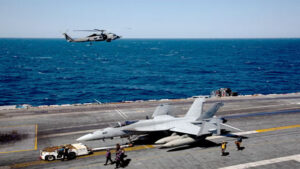 Two U.S. Navy aircraft have gone down in the South China Sea in separate incidents within 30 minutes of each other, according to the U.S. Pacific Fleet.
Two U.S. Navy aircraft have gone down in the South China Sea in separate incidents within 30 minutes of each other, according to the U.S. Pacific Fleet.
President Donald Trump described the back-to-back crashes as “very unusual” and suggested a possible fuel issue while speaking to reporters on board Air Force One Monday, during his flight from Malaysia to Japan. “They think it might be bad fuel. We’re gonna find out. Nothing to hide, sir,” Trump said in response to a reporter’s question.
The two aircraft were conducting routine operations over disputed waters, which China claims to own. Five crew members were involved, all of whom have been safely rescued. Both aircraft were deployed from the aircraft carrier USS Nimitz.
The U.S. Navy MH-60R Sea Hawk helicopter went down in the waters of the South China Sea at around 2:45 p.m. local time Sunday. All three crew members were recovered safely.
Just 30 minutes later, at 3:15 p.m., a $60m F/A-18 Super Hornet fighter jet also crashed while conducting routine operations from the USS Nimitz. Two crew members ejected from the plane and were later recovered.
The Sea Hawk is assigned to the “Battle Cats” in Helicopter Maritime Strike Squadron 73. The Super Hornet was part of the “Fighting Redcocks” of Strike Fighter Squadron 22.
China’s foreign ministry said Beijing would be willing to assist in any rescue and recovery operations.
Spokesperson Guo Jiakun said at a Monday press conference that China “will provide necessary aid from a humanitarian perspective if the U.S. asks.”
He also took the opportunity to criticize U.S. operations in the region, accusing Washington of carrying out regular displays of military force in the South China Sea, increasing the risk to maritime activity, and undermining regional peace.
“All personnel involved are safe and in stable condition,” the Pacific Fleet, the world’s largest fleet command, said in a statement. They added that an investigation had been launched into both incidents.
This is the fourth F/A-18 that the navy has lost this year.
At the time of the incident, the USS Nimitz was returning to its home port in Naval Base Kitsap in Washington after being deployed to the Middle East for most of the summer as part of the U.S. response to attacks by Yemen’s Houthi rebels on commercial shipping. The carrier was on its final deployment before being decommissioned.
First commissioned in 1975, the Nimitz is the U.S. Navy’s oldest serving aircraft carrier, and is slated for retirement in 2026.
Nimitz-class aircraft carriers are the biggest ships in the navy, measuring almost 1,100 feet from bow to stern. They can operate continuously for 20 years without refueling because they are nuclear powered.
The incidents occurred amid Trump’s tour of Asia, during which he is expected to meet a host of Asian leaders, including President Xi Jinping of China.
China has been ramping up efforts to bolster its territorial claims in the South China Sea amid ongoing disputes over numerous islands and waterways with other Southeast Asian nations. Beijing has been asserting its ownership over almost all of the strategic waterway.
U.S. forces maintain a presence in the region to support regional allies and push back on Chinese sovereignty claims.
